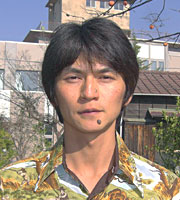I am interested in intelligence of lower animals. Intelligence of
human beings is their ability to change environment and let it fit to
their lives. On the other hand, intelligence of lower animals is their
ability to change themselves and harmonize with environment.
I chose pill bugs (Armadillidium vulgare, Isopoda, Crustacean) as
subjects and have invented some behavioral experiments to approach to intelligence
of lower animals. In the recent experiment, each bug was placed on an annulus-shaped
substrate surrounded by water (test condition) or acrylic wall (control
condition). Small obstacles were introduced at regular intervals in the
middle of the annulus. The bugs, whose eyes can perceive only different
shades of light or dark, moved along the water, touching the obstacles repeatedly.
However, as they are destined to die staying in water, moving along the
water becomes dangerous.
Under such condition, the bugs demonstrated mounting to the obstacles.
Sometimes, this mounting behavior was observed recurrently. In the control
condition, mounting behavior happened rarely. From these results, we concluded
that they gradually learned the arrangement of water and obstacles by touching
them with their antennae and tried to mount the obstacles in order to decrease
the probability of direct contact with water.
In this tenure-track system, I plan to make automatic video tracking
system to observe every antennal movement in the experiment precisely and
reveal the patterns of antennal movement that may play a significant role
in obtaining external spatial information and expressing the mounting behavior.
Starting from this experiment, I try to elucidate the unknown neural mechanism
which constructs the global spatial representation from the local antennal
inputs and approach intelligence of lower animals.
Profile

Tohru MORIYAMA
- Research Area:
- Comparative Cognition
- Keywords:
- Intelligence, Mind, Autonomy, Pill Bug, Bioengineering
- Contact:
- 3-15-1 Tokida, Ueda-shi, Nagano-ken
Japan 386-8567
Tel: +81-268-21-5589
E-mail: toru[at-mark]shinshu-u.ac.jp - URL:
- http://bs.shinshu-u.ac.jp/moriyama/index.html
Employment Experience:
April, 1993-March, 1996:
Engineer of Itami Works, Mitsubishi Electric Corporation
April, 1998-March, 1997:
Junior Research Associate of Bio-Mimetic Control Center,
RIKEN
April, 1999-March, 2000:
Research Student, Graduate School of Science and Technology,
Kobe University
April, 2000-March, 2007:
Research Associate, School of Systems Information Science,
Future University-Hakodate
April, 2007-October, 2007:
Assistant Professor, School of Systems Information Science, Future University-Hakodate
November, 2007-:
Tenure-Track Assistant Professor, Young Researcher Empowerment
Project, Shinshu University
Education:
1991:
B.S. from Department of Chemistry, Faculty of Science,
Kobe University
1993:
M.S. from Graduate School of Science, Kobe University
1999:
D.S. from Graduate School of Science and Technology,
Kobe University
Awards:
1998:
Best Paper Award in CASYS ‘98
2005:
Best Paper Award in CASYS ’05
2005:
Incentive Paper Award from Japanese Cognitive Science
Society
Selected Publications:
- Moriyama T, Kojima T, Sakuma M
“Active Antennal Searching Suggesting Anticipatory Capability in Pill Bugs.” International Journal of Computing Anticipatory Systems 21: 37-44, 2008. - Moriyama T, Takeda T
“ Exploration of Environment by Antennae Wearing Teflon Tubes in Pill Bugs.” In: S. Cummins-Sebree, Riley M, Shockley K eds. Studies in Perception & Action IX, Lawrence Erlbaum Associates, pp50-52, 2007. - Moriyama T, Riabov VB, Migita M
“ The Ability to Express Multiple-Choice Behavior in Pill Bugs.” Cognitive Studies 12: 188-206, 2005. - Moriyama T
“ Problem Solving and Autonomous Behavior in Pill Bugs.” Ecological Psychology 16: 287-302, 2004 - Moriyama T
“ Decision-making and Turn Alternation in Pill Bugs.” International Journal of Comparative Psychology 12: 153-170, 1999.
Research Statement
My goal:
I would like to establish research group of physiology to
elucidate the neural system for the global spatial cognition resulting from
the local antennal inputs and that of mathematics and computational science
to construct the mathematical model of the neural system.
We can expect that these researches may contribute to the construction
of the pill bug robot. In every research process, I try to keep thinking what
intelligence of lower animals is, whether there is mind in them or not, and
one of the biggest problems in science, what the mind is.